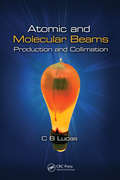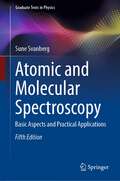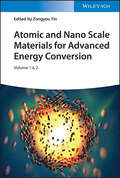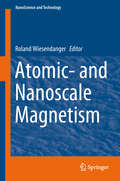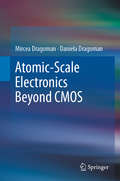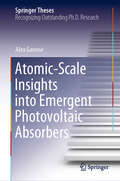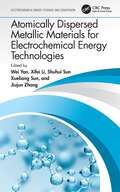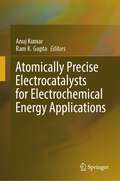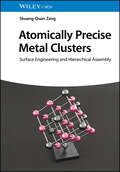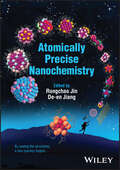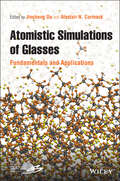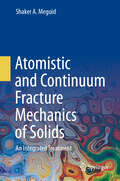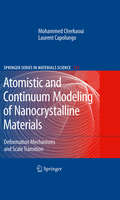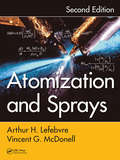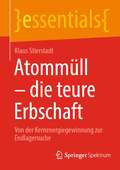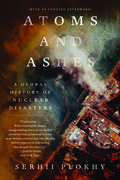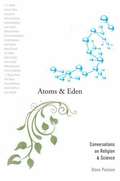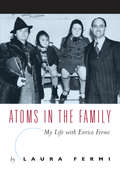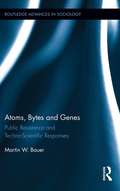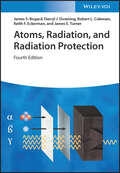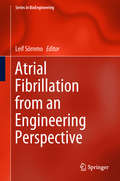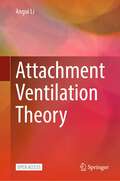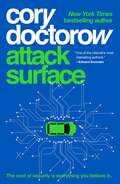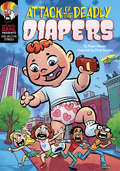- Table View
- List View
Atomic and Molecular Beams: Production and Collimation
by Cyril Bernard LucasAtomic and molecular beams are employed in physics and chemistry experiments and, to a lesser extent, in the biological sciences. These beams enable atoms to be studied under collision-free conditions and allow the study of their interaction with other atoms, charged particles, radiation, and surfaces. Atomic and Molecular Beams: Production and Col
Atomic and Molecular Spectroscopy: Basic Aspects and Practical Applications (Graduate Texts in Physics)
by Sune SvanbergA wide-ranging review of modern spectroscopic techniques such as X-ray, photoelectron, optical and laser spectroscopy, and radiofrequency and microwave techniques. On the fundamental side the book focuses on physical principles and the impact of spectroscopy on our understanding of the building blocks of matter, while in the area of applications particular attention is given to those in chemical analysis, photochemistry, surface characterisation, environmental and medical diagnostics, remote sensing and astrophyscis. The Fourth Edition also provides the reader with an update on laser cooling and trapping, Bose-Einstein condensation, ultra-fast spectroscopy, high-power laser/matter interaction, satellite-based astronomy and spectroscopic aspects of laser medicine.
Atomic and Nano Scale Materials for Advanced Energy Conversion
by Zongyou YinAtomic and Nano Scale Materials for Advanced Energy Conversion Discover the latest advancements in energy conversion technologies used to develop modern sustainable energy techniques In Atomic and Nano Scale Materials for Advanced Energy Conversion, expert interdisciplinary researcher Dr. Zongyou Yin delivers a comprehensive overview of nano-to-atomic scale materials science, the development of advanced electrochemical, photochemical, photoelectrochemical, and photovoltaic energy conversion strategies, and the applications for sustainable water splitting and other technologies. The book offers readers cutting-edge information of two-dimensional nano, mixed-dimensional nano, nano rare earth, clusters, and single atoms. It constructively evaluates emerging nano-to-atomic scale energy conversion technologies for academic research and development (R&D) researchers and industrial technique consultants and engineers. The author sets out a systematic analysis of recent energy-conversion science, covering topics like adaptable manufacturing of Van der Waals heterojunctions, mixed-dimensional junctions, tandem structures, and superlattices. He also discusses function-oriented engineering in polymorphic phases, photon absorption, excitons-charges conversion, non-noble plasmonics, and solid-liquid-gas interactions. Readers will also benefit from: A thorough introduction to emerging nanomaterials for energy conversion, including electrochemical, photochemical, photoelectrochemical, and photovoltaic energy conversion An exploration of clusters for energy conversion, including electrochemical, photochemical, and photoelectrochemical clusters Practical discussions of single atoms for energy conversion in electrochemical, photochemical, and photoelectrochemical energy conversion technologies A thorough analysis of future perspectives and directions in advanced energy conversion technology Perfect for materials scientists, photochemists, electrochemists, and inorganic chemists, Atomic and Nano Scale Materials for Advanced Energy Conversion is also a must-read resource for catalytic chemists interested in the intersection of advanced chemistry and physics in energy conversion technologies.
Atomic- and Nanoscale Magnetism (NanoScience and Technology)
by Roland Wiesendanger<p>This book provides a comprehensive overview of the fascinating recent developments in atomic- and nanoscale magnetism, including the physics of individual magnetic adatoms and single spins, the synthesis of molecular magnets for spintronic applications, and the magnetic properties of small clusters as well as non-collinear spin textures, such as spin spirals and magnetic skyrmions in ultrathin films and nanostructures. <p>Starting from the level of atomic-scale magnetic interactions, the book addresses the emergence of many-body states in quantum magnetism and complex spin states resulting from the competition of such interactions, both experimentally and theoretically. It also introduces novel microscopic and spectroscopic techniques to reveal the exciting physics of magnetic adatom arrays and nanostructures at ultimate spatial and temporal resolution and demonstrates their applications using various insightful examples. The book is intended for researchers and graduate students interested in recent developments of one of the most fascinating fields of condensed matter physics.</p>
Atomic-Scale Electronics Beyond CMOS
by Mircea Dragoman Daniela DragomanThis book explores emerging topics in atomic- and nano-scale electronics after the era of Moore’s Law, covering both the physical principles behind, and technological implementations for many devices that are now expected to become key elements of the future of nanoelectronics beyond traditional complementary metal-oxide semiconductors (CMOS). Moore’s law is not a physical law itself, but rather a visionary prediction that has worked well for more than 50 years but is rapidly coming to its end as the gate length of CMOS transistors approaches the length-scale of only a few atoms. Thus, the key question here is: “What is the future for nanoelectronics beyond CMOS?” The possible answers are found in this book. Introducing novel quantum devices such as atomic–scale electronic devices, ballistic devices, memristors, superconducting devices, this book also presents the reader with the physical principles underlying new ways of computing, as well as their practical implementation. Topics such as quantum computing, neuromorphic computing are highlighted here as some of the most promising candidates for ushering in a new era of atomic-scale electronics beyond CMOS.
Atomic-Scale Insights into Emergent Photovoltaic Absorbers (Springer Theses)
by Alex GanoseThis book presents an original investigation into alternative photovoltaic absorbers. Solar power is a highly promising renewable energy solution; however, its success is hampered by the limited cost-effectiveness of current devices. The book assesses the photovoltaic performance of over 20 materials using state-of-the-art, first-principles methods. Adopting a computational approach, it investigates atomic-scale properties at a level of accuracy that is difficult to achieve using laboratory-based experimental techniques. Unlike many theoretical studies, it provides specific advice to those involved in experimental investigations. Further, it proposes directions for future research. This book advances the field of photovoltaics in three crucial ways: firstly, it identifies why one class of proposed materials cannot achieve high efficiency, while at the same time gaining insights that can be used to design future absorbers. Secondly, it shows that poor performance in the bismuth chalcohalides is not due to fundamental limitations, and can be overcome by finely controlling synthesis conditions. Lastly, it describes a range of new stable materials that are expected to show excellent photovoltaic performance.
Atomically Dispersed Metallic Materials for Electrochemical Energy Technologies (Electrochemical Energy Storage and Conversion)
by Jiujun Zhang Xueliang Sun Wei Yan Shuhui Sun Xifei LiAtomically dispersed metallic materials (ADMMs) are the most advanced materials used in energy conversion and storage devices to improve their performance for portable electronics, electric vehicles, and stationary power stations. Atomically Dispersed Metallic Materials for Electrochemical Energy Technologies aims to facilitate research and development of ADMMs for applications in electrochemical energy devices. It provides a comprehensive description of the science and technology of ADMMs, including material selection, synthesis, characterization, and their applications in fuel cells, batteries, supercapacitors, and H2O/CO2/N2 electrolysis to encourage progress in commercialization of these clean energy technologies. Offers a comprehensive introduction to various types of ADMMs, their fabrication and characterization, and how to improve their performance Analyzes, compares, and discusses advances in different ADMMs in the application of electrochemical energy devices, including commercial requirements Describes cutting-edge methodologies in composite ADMM design, selection, and fabrication Summarizes current achievements, challenges, and future research directions Written by authors with strong academic and industry expertise, this book will be attractive to researchers and industry professionals working in the fields of materials, chemical, mechanical, and electrical engineering, as well as nanotechnology and clean energy.
Atomically Precise Electrocatalysts for Electrochemical Energy Applications
by Anuj Kumar Ram K. GuptaThis book offers a comprehensive overview of atomically precise electrocatalysts, including single-atom, dual-atom, and multi-atom catalysts, which are considered to be superior electrode materials for fuel cells and water electrolyzers. By presenting a systematic examination of these materials in ascending order of metal atom number, the book provides a deep understanding of their synthesis processes, energy applications, and potential for improving their performance. Unlike any contemporary book on the topic, this book explores the reaction mechanisms and structure-performance relationships in catalytic processes at atomic level. Essentially, by driving the development of fuel cells and water electrocatalyzers, this book helps meet the world's growing energy demands. With its cutting-edge insights, this book is an indispensable resource for researchers, engineers, and students working in the field of renewable energy.
Atomically Precise Metal Clusters: Surface Engineering and Hierarchical Assembly
by Shuang-Quan ZangAtomically Precise Metal Clusters Thorough discussion on how surface modification and self-assembly play roles in the atomically precise formation and property tailoring of molecular clusters Atomically Precise Metal Clusters: Surface Engineering and Hierarchical Assembly summarizes and discusses the surface modification, assembly, and property tailoring of a wide variety of nanoclusters, including the well-explored metal clusters, addressing the structure–property relationships throughout. The atomic-level control in synthesis, new types of structures, and physical/chemical properties of nanoclusters are illustrated in various chapters. The controlled modification and assembly of metal nanoclusters is expected to have a major impact on future nanoscience research and other areas, with distinctive metal cluster-based function materials with precise structures uncovering exciting opportunities in both fundamental research and practical applications. Written by a highly qualified academic with significant research experience in the field, Atomically Precise Metal Clusters includes information on: Ligand engineering and assembly of coinage metal nanoclusters such as gold, silver, and copperRecent advances in post-modification of polyoxometalates and small transition metal chalcogenide superatom clustersSynthesis and assembly of cadmium chalcogenide supertetrahedral clusters and modification and assembly of Fe-S clustersIndium phosphide magic-sized clusters, ligand-tailoring platinum and palladium clusters, and metal oxo clusters (MOCs)Enabling access to desired functions in metal clusters for catalysis, optics, biomedicine, and other fields through surface engineering and supramolecular assembly A timely and comprehensive book that summarizes the recent progress in the surface modification and self-assembly of metal nanoclusters, Atomically Precise Metal Clusters provides essential guidance for graduate students and advanced researchers in material science, chemistry, biomedicine, and other disciplines.
Atomically Precise Nanochemistry
by De-En Jiang Rongchao JinAtomically Precise Nanochemistry Explore recent progress and developments in atomically precise nanochemistry Chemists have long been motivated to create atomically precise nanoclusters, not only for addressing some fundamental issues that were not possible to tackle with imprecise nanoparticles, but also to provide new opportunities for applications such as catalysis, optics, and biomedicine. In Atomically Precise Nanochemistry, a team of distinguished researchers delivers a state-of-the-art reference for researchers and industry professionals working in the fields of nanoscience and cluster science, in disciplines ranging from chemistry to physics, biology, materials science, and engineering. A variety of different nanoclusters are covered, including metal nanoclusters, semiconductor nanoclusters, metal-oxo systems, large-sized organometallic nano-architectures, carbon clusters, and supramolecular architectures. The book contains not only experimental contributions, but also theoretical insights into the atomic and electronic structures, as well as the catalytic mechanisms. The authors explore synthesis, structure, geometry, bonding, and applications of each type of nanocluster. Perfect for researchers working in nanoscience, nanotechnology, and materials chemistry, Atomically Precise Nanochemistry will also benefit industry professionals in these sectors seeking a practical and up-to-date resource.
Atomistic Simulations of Glasses: Fundamentals and Applications
by Jincheng Du Alastair N. CormackA complete reference to computer simulations of inorganic glass materials In Atomistic Simulations of Glasses: Fundamentals and Applications, a team of distinguished researchers and active practitioners delivers a comprehensive review of the fundamentals and practical applications of atomistic simulations of inorganic glasses. The book offers concise discussions of classical, first principles, Monte Carlo, and other simulation methods, together with structural analysis techniques and property calculation methods for the models of glass generated from these atomistic simulations, before moving on to practical examples of the application of atomistic simulations in the research of several glass systems. The authors describe simulations of silica, silicate, aluminosilicate, borosilicate, phosphate, halide and oxyhalide glasses with up-to-date information and explore the challenges faced by researchers when dealing with these systems. Both classical and ab initio methods are examined and comparison with experimental structural and property data provided. Simulations of glass surfaces and surface-water reactions are also covered. Atomistic Simulations of Glasses includes multiple case studies and addresses a variety of applications of simulation, from elucidating the structure and properties of glasses for optical, electronic, architecture applications to high technology fields such as flat panel displays, nuclear waste disposal, and biomedicine. The book also includes: A thorough introduction to the fundamentals of atomistic simulations, including classical, ab initio, Reverse Monte Carlo simulation and topological constraint theory methods Important ingredients for simulations such as interatomic potential development, structural analysis methods, and property calculations are covered Comprehensive explorations of the applications of atomistic simulations in glass research, including the history of atomistic simulations of glasses Practical discussions of rare earth and transition metal-containing glasses, as well as halide and oxyhalide glasses In-depth examinations of glass surfaces and silicate glass-water interactions Perfect for glass, ceramic, and materials scientists and engineers, as well as physical, inorganic, and computational chemists, Atomistic Simulations of Glasses: Fundamentals and Applications is also an ideal resource for condensed matter and solid-state physicists, mechanical and civil engineers, and those working with bioactive glasses. Graduate students, postdocs, senior undergraduate students, and others who intend to enter the field of simulations of glasses would also find the book highly valuable.
Atomistic and Continuum Fracture Mechanics of Solids: An Integrated Treatment
by Shaker A. MeguidThis unique, first of its kind, book offers an integrated treatment of the atomistic-continuum behaviours of single and interacting microdefects under elasto-static loading. These microdefects may take the form of nanocracks, microcracks, microvoids, inclusions, and inhomogeneities. Professor Meguid elucidates the subject matter using novel treatment that offers a fresh look at molecular and continuum mechanics, imperfections in solids, the Griffith crack, modes of failure and diagnostics at varied length scales, LEFM and multiscale modeling of interacting microdefects. Providing a range of perspectives from theory and applications, this book is ideal for college seniors, graduate students, practicing and research engineers interested in failure analysis, diagnostics and prevention.
Atomistic and Continuum Modeling of Nanocrystalline Materials: Deformation Mechanisms and Scale Transition (Springer Series in Materials Science #112)
by Laurent CapolungoAtomistic and Continuum Modeling of Nanocrystalline Materials develops a complete and rigorous state-of-the-art analysis of the modeling of the mechanical behavior of nanocrystalline (NC) materials. Among other key topics, the material focuses on the novel techniques used to predict the behavior of nanocrystalline materials. Particular attention is given to recent theoretical and computational frameworks combining atomistic and continuum approaches. Also, the most relevant deformation mechanisms governing the response of nanocrystalline materials are addressed and discussed in correlation with available experimental data.
Atomization and Sprays
by Arthur H. Lefebvre Vincent G. McDonellThe second edition of this long-time bestseller provides a framework for designing and understanding sprays for a wide array of engineering applications. The text contains correlations and design tools that can be easily understood and used in relating the design of atomizers to the resulting spray behavior. Written to be accessible to readers with a modest technical background, the emphasis is on application rather than in-depth theory. Numerous examples are provided to serve as starting points for using the information in the book. Overall, this is a thoroughly updated edition that still retains the practical focus and readability of the original work by Arthur Lefebvre.
Atommüll - die teure Erbschaft: Von der Kernenergiegewinnung zur Endlagersuche (essentials)
by Klaus StierstadtBei der Energiegewinnung aus Atomkernen entstehen radioaktive Abfälle. Deren radioaktive Strahlung ist für belebte Materie außerordentlich schädlich. Solche Strahlenschäden werden besprochen und mit der natürlichen Strahlenbelastung verglichen. Der Atommüll muss sorgfältig entsorgt werden, was bis heute kaum geschieht. Die Möglichkeiten und Probleme einer sicheren Endlagerung werden diskutiert.
Atoms and Ashes: A Global History Of Nuclear Disasters
by Serhii PlokhyA chilling account of more than half a century of nuclear catastrophes, by the author of the “definitive” (Economist) Cold War history, Nuclear Folly. Almost 145,000 Americans fled their homes in and around Harrisburg, Pennsylvania, in late March 1979, hoping to save themselves from an invisible enemy: radiation. The reactor at the nearby Three Mile Island nuclear power plant had gone into partial meltdown, and scientists feared an explosion that could spread radiation throughout the eastern United States. Thankfully, the explosion never took place—but the accident left deep scars in the American psyche, all but ending the nation’s love affair with nuclear power. In Atoms and Ashes, Serhii Plokhy recounts the dramatic history of Three Mile Island and five more accidents that that have dogged the nuclear industry in its military and civil incarnations: the disastrous fallout caused by the testing of the hydrogen bomb in the Bikini Atoll in 1954; the Kyshtym nuclear disaster in the USSR, which polluted a good part of the Urals; the Windscale fire, the worst nuclear accident in the UK’s history; back to the USSR with Chernobyl, the result of a flawed reactor design leading to the exodus of 350,000 people; and, most recently, Fukushima in Japan, triggered by an earthquake and a tsunami, a disaster on a par with Chernobyl and whose clean-up will not take place in our lifetime. Through the stories of these six terrifying incidents, Plokhy explores the risks of nuclear power, both for military and peaceful purposes, while offering a vivid account of how individuals and governments make decisions under extraordinary circumstances. Today, there are 440 nuclear reactors operating throughout the world, with nuclear power providing 10 percent of global electricity. Yet as the world seeks to reduce carbon emissions to combat climate change, the question arises: Just how safe is nuclear energy?
Atoms and Eden: Conversations on Religion and Science
by Steve PaulsonHere is an unprecedented collection of twenty freewheeling and revealing interviews with major players in the ongoing--and increasingly heated--debate about the relationship between religion and science. These lively conversations cover the most important and interesting topics imaginable: the Big Bang, the origins of life, the nature of consciousness, the foundations of religion, the meaning of God, and much more. In Atoms and Eden, Peabody Award-winning journalist Steve Paulson explores these topics with some of the most prominent public intellectuals of our time, including Richard Dawkins, Karen Armstrong, E. O. Wilson, Sam Harris, Elaine Pagels, Francis Collins, Daniel Dennett, Jane Goodall, Paul Davies, and Steven Weinberg. The interviewees include Christians, Buddhists, Jews, and Muslims, as well as agnostics, atheists, and other scholars who hold perspectives that are hard to categorize. Paulson's interviews sweep across a broad range of scientific disciplines--evolutionary biology, quantum physics, cosmology, and neuroscience--and also explore key issues in theology, religious history, and what William James called ''the varieties of religious experience. '' Collectively, these engaging dialogues cover the major issues that have often pitted science against religion--from the origins of the universe to debates about God, Darwin, the nature of reality, and the limits of human reason. These are complex, intellectually rich discussions, presented in an accessible and engaging manner. Most of these interviews were originally published as individual cover stories for Salon. com, where they generated a huge reader response. Public Radio's "To the Best of Our Knowledge" will present a major companion series on related topics this fall. A feast of ideas and competing perspectives, this volume will appeal to scientists, spiritual seekers, and the intellectually curious.
Atoms in the Family: My Life with Enrico Fermi
by Laura FermiIn this absorbing account of life with the great atomic scientist Enrico Fermi, Laura Fermi tells the story of their emigration to the United States in the 1930s—part of the widespread movement of scientists from Europe to the New World that was so important to the development of the first atomic bomb. Combining intellectual biography and social history, Laura Fermi traces her husband's career from his childhood, when he taught himself physics, through his rise in the Italian university system concurrent with the rise of fascism, to his receipt of the Nobel Prize, which offered a perfect opportunity to flee the country without arousing official suspicion, and his odyssey to the United States.
Atoms in the Family: My Life with Enrico Fermi
by Laura FermiIn this absorbing account of life with the great atomic scientist Enrico Fermi, Laura Fermi tells the story of their emigration to the United States in the 1930s—part of the widespread movement of scientists from Europe to the New World that was so important to the development of the first atomic bomb. Combining intellectual biography and social history, Laura Fermi traces her husband's career from his childhood, when he taught himself physics, through his rise in the Italian university system concurrent with the rise of fascism, to his receipt of the Nobel Prize, which offered a perfect opportunity to flee the country without arousing official suspicion, and his odyssey to the United States.
Atoms, Bytes and Genes: Public Resistance and Techno-Scientific Responses (Routledge Advances in Sociology #126)
by Martin W. Bauer"Atom," "byte" and "gene" are metonymies for techno-scientific developments of the 20th century: nuclear power, computing and genetic engineering. Resistance continues to challenge these developments in public opinion. This book traces historical debates over atoms, bytes and genes which raised controversy with consequences, and argues that public opinion is a factor of the development of modern techno-science. The level and scope of public controversy is an index of resistance, examined here with a "pain analogy" which shows that just as pain impacts movement, resistance impacts techno-scientific mobilization: it signals that something is wrong, and this requires attention, elaboration and a response to the challenge. This analysis shows how different fields of enquiry deal with the resistance of social-psychological mentalities in the face of industrial, scientific and political activities inspired by projected futures.
Atoms, Radiation, and Radiation Protection
by James E. Turner Darryl J. Downing James S. Bogard Robert L. Coleman Keith F. EckermanAtoms, Radiation, and Radiation Protection Discover the keys to radiation protection in the fourth edition of this best-selling textbook A variety of atomic and sub-atomic processes, including alpha, beta, and gamma decay or electron ejection from inner atom shells, can produce ionizing radiation. This radiation can in turn produce environmental and biological effects both harmful – including DNA damage and other impacts of so-called ‘radiation sickness’ – and helpful, including radiation treatment for cancerous tumors. Understanding the processes that generate radiation and the steps which can be taken to mitigate or direct its effects is therefore critical in a wide range of industries and medical subfields. For decades, Atoms, Radiation, and Radiation Protection has served as the classic reference work on the subject of ionizing radiation and its safeguards. Beginning with a presentation of fundamental atomic structure and the physical mechanisms which produce radiation, the book also includes thorough discussion of how radiation can be detected and measured, as well as guide-lines for interpreting radiation statistics and detailed analysis of protective measures, both individual and environmental. Now updated by a new generation of leading scholars and researchers, Atoms, Radiation, and Radiation Protection will continue to serve global scientific and industrial research communities. Readers of the fourth edition of Atoms, Radiation, and Radiation Protection will also find: Detailed updates of existing material, including the latest recommendations of the ICRP and NCRP Treatment of current physiokinetic and dosimetric models All statistics now presented in SI units, making the book more globally accessible Atoms, Radiation, and Radiation Protection is a foundational guide for graduate students and researchers in health physics and nuclear physics, as well as related industries.
Atrial Fibrillation from an Engineering Perspective (Series in BioEngineering)
by Leif SörnmoProvides an up-to-date overview of techniques developed for acquisition, analysis, and modeling of bioelectrical signals.<P><P> Presents a wide variety of approaches to characterizing and modeling atrial activity.<P> Emphasizes emerging technologies for monitoring of atrial fibrillation in connection with ischemic stroke, interventional ablation procedures, and pharmacological treatment.<P>Atrial Fibrillation from an Engineering Perspective provides an up-to-date overview of techniques developed for acquisition, modeling, and analysis of noninvasive, bioelectrical signals reflecting this common arrhythmia. Special emphasis is put on emerging technologies for monitoring of atrial fibrillation in connection with ischemic stroke, interventional ablation procedures, and pharmacological treatment, applications which all depend on the availability of techniques for detecting and characterizing episodes of paroxysmal atrial fibrillation. Detectors exploring both rhythm and morphology are described, as well as detectors confined to rhythm and better suited for low power implementation. A wide variety of approaches to modeling and characterization of atrial activity are described, emanating from a statistical and deterministic starting points. This book is suitable for graduate students, researchers, and engineers who want a comprehensive treatise of atrial fibrillation from an engineering perspective. It may be used for self-study, as a supplement to courses in signal processing, or as a modern monograph by researchers in the field of atrial fibrillation.
Attachment Ventilation Theory
by Angui LiThis open access book systematically summarizes the current research progress of attachment ventilation, covering vertical wall attachment, column attachment, and adaptive attachment ventilation. Attachment ventilation is a high-performance ventilation mode that was first proposed by the author, Prof. Angui Li 20 years ago. Now it has been widely used in office spaces, subway stations, high-speed railway stations, international airport terminals, and other large spaces. This book introduces attachment ventilation in detail to eliminate the cooling/heating load of the occupied zone and provide an expected environment for the air-conditioned zone. Attachment ventilation combines the advantages of traditional mixed ventilation and displacement ventilation. This book consists of six chapters, covering a series of airflow patterns, mechanisms, parameter correlations, and attachment ventilation design methods. It is helpful for HVAC engineers to design attachment ventilation effectively.
Attack Surface
by Cory DoctorowCory Doctorow's Attack Surface is a standalone novel set in the world of New York Times bestsellers Little Brother and Homeland. <P><P>Most days, Masha Maximow was sure she'd chosen the winning side. In her day job as a counterterrorism wizard for an transnational cybersecurity firm, she made the hacks that allowed repressive regimes to spy on dissidents, and manipulate their every move. The perks were fantastic, and the pay was obscene.J ust for fun, and to piss off her masters, Masha sometimes used her mad skills to help those same troublemakers evade detection, if their cause was just. It was a dangerous game and a hell of a rush. But seriously self-destructive. And unsustainable. <P><P>When her targets were strangers in faraway police states, it was easy to compartmentalize, to ignore the collateral damage of murder, rape, and torture. But when it hits close to home, and the hacks and exploits she’s devised are directed at her friends and family--including boy wonder Marcus Yallow, her old crush and archrival, and his entourage of naïve idealists--Masha realizes she has to choose. And whatever choice she makes, someone is going to get hurt. At the Publisher's request, this title is being sold without Digital Rights Management Software (DRM) applied.
Attack of the Deadly Diapers (Michael Dahl Presents: Side-Splitting Stories)
by Megan AtwoodIn the midst of a boring summer, soon-to-be fifth grader Angie DelMar discovers something amazing about the eccentric woman who's just moved into town. She is actually a mad scientist who plans to take over the world by enlarging and controlling insects! With the help of her friends Cooper, Genevieve, and Harvey, Angie nabs the mixture and flees. But before they reach safety, the friends encounter a day care center where the mixture is accidentally released. Soon the town is overcome by gigantic toddlers! Can the friends save the town, defeat the scientist, and restore the bawling, blubbering behemoths to their cute and cuddly size?
